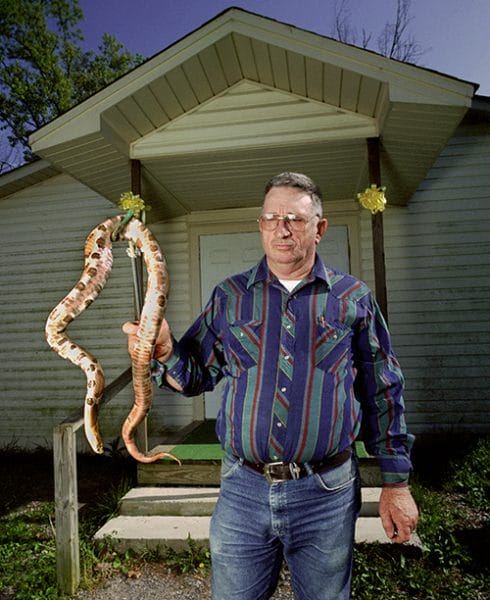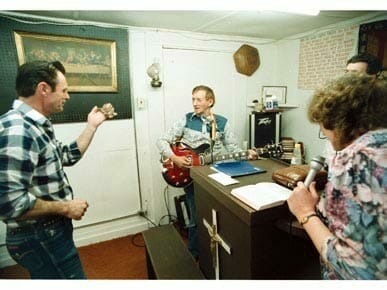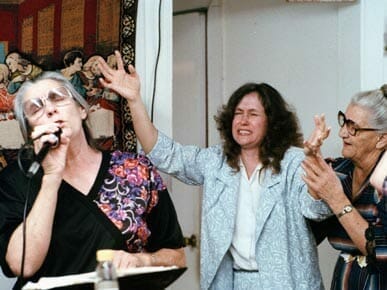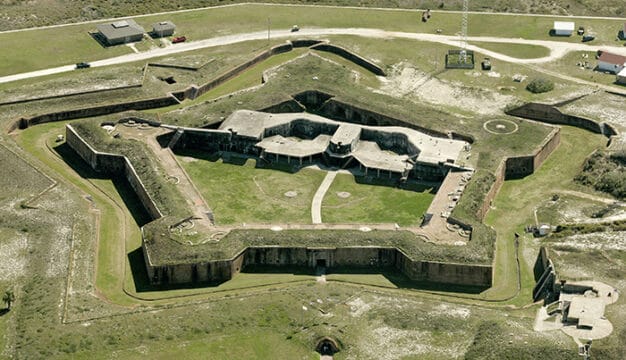Snake Handling
Snake (or serpent) handling in Alabama is practiced primarily by the members of the Church of God with Signs Following. The practice of snake handling first gained a foothold in Alabama in the early nineteenth century and reached its peak in the early twentieth century. The eccentricities and inherent danger of the church’s practices have made it an attractive subject for social scientists. Snake handling is currently outlawed in the state of Alabama, but the practice likely continues in clandestine locations.
 Pastor Billy Summerford in Section
The name of the Church of God with Signs Following and the foundation of its theology come from a literal reading of Mark 16:17-18: “And these signs shall follow them that believe; In my name shall they cast out devils; they shall speak with new tongues; they shall take up serpents; and if they drink any deadly thing, it shall not hurt them; they shall lay hands on the sick, and they shall recover.” So-called serpent handlers also base their religious practices on Mark 16:19-20 and Luke 10:19. In addition to handling serpents, members of the sect also engage in glossolalia (speaking in tongues) and “laying on of hands” (a belief that illnesses and wounds can be healed with the mind) and drink the deadly poison strychnine. Members generally dress plainly and wear little or no jewelry, and women wear their hair long and do not straighten, curl, or color it. Men must keep their hair short and generally wear open-necked, long-sleeved shirts and slacks. All of these practices are derived from biblical passages that are interpreted literally by church members.
Pastor Billy Summerford in Section
The name of the Church of God with Signs Following and the foundation of its theology come from a literal reading of Mark 16:17-18: “And these signs shall follow them that believe; In my name shall they cast out devils; they shall speak with new tongues; they shall take up serpents; and if they drink any deadly thing, it shall not hurt them; they shall lay hands on the sick, and they shall recover.” So-called serpent handlers also base their religious practices on Mark 16:19-20 and Luke 10:19. In addition to handling serpents, members of the sect also engage in glossolalia (speaking in tongues) and “laying on of hands” (a belief that illnesses and wounds can be healed with the mind) and drink the deadly poison strychnine. Members generally dress plainly and wear little or no jewelry, and women wear their hair long and do not straighten, curl, or color it. Men must keep their hair short and generally wear open-necked, long-sleeved shirts and slacks. All of these practices are derived from biblical passages that are interpreted literally by church members.
 Snake Handlers in Scottsboro
George Hensley of Tennessee is credited with introducing snake-handling practices to the Appalachian Pentecostal Church (Church of God, Cleveland, Tennessee) around the turn of the twentieth century. Alabamians who belong to this church, however, claim to follow the teachings of James Miller, who began serpent handling in the Deep South and brought the practice to the Scottsboro area around Sand Mountain in about 1912, apparently independently of Hensley. The Church of God with Signs Following is run by followers of Miller. The church follows doctrines and practices that are much like those of the Church of God and other similar denominations.
Snake Handlers in Scottsboro
George Hensley of Tennessee is credited with introducing snake-handling practices to the Appalachian Pentecostal Church (Church of God, Cleveland, Tennessee) around the turn of the twentieth century. Alabamians who belong to this church, however, claim to follow the teachings of James Miller, who began serpent handling in the Deep South and brought the practice to the Scottsboro area around Sand Mountain in about 1912, apparently independently of Hensley. The Church of God with Signs Following is run by followers of Miller. The church follows doctrines and practices that are much like those of the Church of God and other similar denominations.
Despite the stereotype in popular culture that snake handling is common among Appalachian Protestant religious sects, few people in the United States—and even fewer in Alabama—actually practice it. In his 1993 book Serpent Handling Believers, English professor Thomas Burton estimates that at the time there were between only 1,000 and 2,000 total members of the Church of God with Signs Following in the entire United States. It is difficult to estimate the exact number of serpent handlers who live in Alabama—or nationwide for that matter—because the sect is not public or open in its practices. The Church of God with Signs Following has a long history of independence from any national denomination and in fact grew out of a tradition of religious autonomy. It is an outgrowth of the Calvinist Appalachian Pentecostal-Holiness church, which the Scots-Irish brought to the region in the late-eighteenth century.
Like many of the independent churches in Appalachia, the Church of God with Signs Following does not answer to a national denomination, nor does it rely on a centralized ordination process. Many scholars attribute this autonomy to the fact that such churches emerged in isolated Appalachian communities; for many years Appalachian churches have been evolving distinctly from mainstream denominations, and their relative isolation has long made them targets for stereotyping by outsiders. The publicity surrounding snake handling has drawn the ire of many rural religious communities for fostering negative stereotypes about them.
 Church of God with Signs Following
One of the best-known names in Alabama’s Church of God with Signs Following is Glenn Summerford of Scottsboro, who was profiled in a nonfiction work by Dennis Covington of Birmingham. Summerford had risen to a high level of church hierarchy as a preacher when his wife, Darlene, accused him of attempted murder in 1991. She was hospitalized with a series of snake bites and accused Summerford of forcing her hand into a box full of snakes. He was convicted and sentenced to 99 years in jail. Covington’s award-winning book details his own experiences inside the church, including his attempts at snake handling.
Church of God with Signs Following
One of the best-known names in Alabama’s Church of God with Signs Following is Glenn Summerford of Scottsboro, who was profiled in a nonfiction work by Dennis Covington of Birmingham. Summerford had risen to a high level of church hierarchy as a preacher when his wife, Darlene, accused him of attempted murder in 1991. She was hospitalized with a series of snake bites and accused Summerford of forcing her hand into a box full of snakes. He was convicted and sentenced to 99 years in jail. Covington’s award-winning book details his own experiences inside the church, including his attempts at snake handling.
Snake handlers have earned a reputation for eccentricity among the general public, particularly as a result of the publicity surrounding injuries and deaths that have occurred among members from handling live poisonous snakes. In the 1940s, snake handling disappeared from public notice, but the practice regained media attention with the death from snake bite of a church member in Tennessee in 1947. This led Tennessee to ban snake handling, and Alabama quickly followed suit. As of now, the state of Alabama prohibits displaying a reptile in a manner that endangers anyone.
Additional Resources
Burton, Thomas G. Serpent-Handling Believers. Knoxville: University of Tennessee Press, 1993.
Covington, Dennis. Salvation on Sand Mountain: Snake Handling and Redemption in Southern Appalachia. Reading, Mass.: Addison-Wesley, 1995.
McCauley, Deborah V. Appalachian Mountain Religion: A History. Urbana: University of Illinois Press, 1995.



